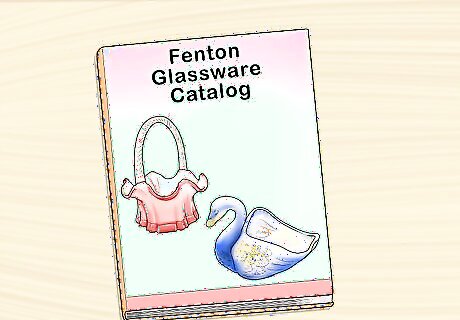
views
Finding Fenton Markings

Check for a sticker on the bottom of your item. Before 1970, Fenton glass was usually marked with oval stickers. Many of these stickers were lost or removed over time, but some of them are still attached. The stickers are often affixed to the bottom of the glass. Stickers may be an oval foil sticker with scalloped or smooth edges.

Examine carnival glass for an oval logo starting from about 1970. The first Fenton logo to be stamped into the glass was the word Fenton inside of an oval. It can be found on carnival glass pieces including vases, dishes, and decorative items that were made starting in 1970. This logo was added to hobnail glass pieces, which have a bumpy texture, beginning in 1972-1973. Some of Fenton’s markings are obscured during finishing treatments. If a mark isn’t obvious immediately, look again more closely for a faint, raised oval.

Check for a small number in the oval that denotes the year. In the 1980s, Fenton added a number 8 to the logo to indicate the decade when the pieces were made. They used a 9 during the 90s and a 0 from 2000 to the present. These numbers may be small and hard to see.

Examine the piece for a cursive F in an oval. If your piece is marked with an F in an oval, it indicates that the glass mold was originally owned by a company other than Fenton, and Fenton later acquired that mold. This mark came into use in 1983.

Check for a flame or a star on the piece. You may notice a flame which resembles the letter S, a solid star, or the outline of a star somewhere on your item. This indicates that the piece is a second, or was found to have some defect while still at the factory. These pieces can still be collectible. Beginning in 1998, an uppercase block F was used to mark seconds.
Identifying Unmarked Pieces

Check the bottom of the glass for a pontil mark, which Fenton doesn't have. Some glass makers use punty rods to hold a glass piece during the crafting process. When it’s removed, it leaves a mark called a pontil mark. Fenton uses snap rings, so most of their pieces will not have a pontil mark. Pontil marks might look like a chip in the glass, a bumpy lump, or a dimple in the bottom of the glass. Fenton has created some offhand glass pieces which do have a pontil mark. These include some very rare pieces from the 1920s and a few contemporary hand blown collections.

Purchase a collector’s book or find a Fenton glassware catalogue. Study the pictures in your books to familiarize yourself with Fenton’s style. By studying existing pictures, you’ll be able to identify characteristics which distinguish Fenton from other manufacturers. For instance, if you find a carnival glass dish featuring a peacock, you can distinguish it from other manufacturer’s of the period by noting that in a Fenton piece, the peacock’s neck will be completely straight, while others curve slightly.

Pay special attention to the bases and edges of Fenton’s glass. The base will have a flat, collared surface, or it may have a ball or spatula feet. The edges are often smooth, bracketed, crimped, or ruffled, and are one of Fenton’s most recognizable characteristics. Fenton primarily produced carnival glass, which has an iridescent sheen, although some of their pieces are opalescent glass, which is translucent. Fenton also specialized in a form of glass known as Hobnail, which is covered with small button-like bumps.

Look for bubbles or flaws in the glass, which Fenton shouldn't have. Fenton glass is extremely high quality, and it should be free of air bubbles or other flaws. If your piece has obvious manufacturing flaws, it is unlikely to be Fenton glass.

Contact a Fenton dealer or an antique expert if you still have questions. Due to similarities between manufacturers, it can be very difficult to tell the difference between some pieces. If you aren't able to tell after examining your piece, look online to find a Fenton dealer or an antique dealer in your area who specializes in Fenton glass.




















Comments
0 comment